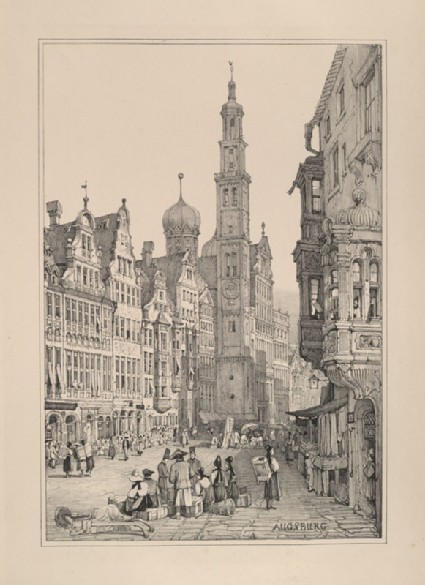Browse: 1470 objects
- Reference URL
Actions
Augsburg Charles Joseph Hullmandel
-
Curator’s description:
Description
The print focusses on the Perlachturm and, beyond it, the facade and twin onion domes of the Rathaus in Augsburg. The print was the thirty-fifth plate in Samuel Prout's "Facsimiles of Sketches made in Flanders and Germany", published in 1833; Ruskin's father is listed among the subscribers to the volume. The original drawing on which the lithograph is based was presumably made in 1823, when Prout seems to have visited Augsburg.
The print was first listed in the collection in 1906, when Cook and Wedderburn listed it as the third item in Case II of the Working Series. As the print can no longer be found (it was recorded as missing in 1981), it is represented here by a surrogate drawn from the copy of Prout's "Flanders and Germany" in the John Johnson Collection in the Bodleian Library.
Ruskin gave a detailed description of his reasons for admiring Prout's work in the "Notes on Prout and Hunt" which he composed to accompany an exhibition of the artists' work at the Fine Art Society in 1879-1880. He stated that Prout possessed 'a genius as earnest as it was humble, doing work not in its essence romantic at all; but, on the contrary, the only quite useful, faithful, and evermore serviceable work that the [Old Water-Colour] Society - by hand of any of its members - had ever done, or could ever, in that phase of its existence, do' (§ 29 = XIV.391).
Prout's work delighted in the dilapidated and the old, and in portraying it rather than trying to produce a narrative or evoke sentiment; it was 'painting - as mere painting' (§ 27 = XIV.389), focussing on the art of depiction in its own right (cf. The Eagle's Nest, § 87 = XXII.185; and Samuel Prout, § 11 = XII.313-314, where the much younger Ruskin praised Prout's depictions of the picturesque; likewise in The Elements of Drawing, § 257 = XV.221-222). Prout's work was, importantly unaffected. Like Turner, Bewick and William Henry Hunt, Prout could draw the poor, but not the rich - because he seldom drew active figures. 'He understood, and we do not, the meaning of the word "quiet"' (§ 42 = XIV.402).
Ruskin also praised Prout's abilities as a consummate draughtsman: 'Prout is not a colourist, nor in any extended or complete sense of the word a painter. He is essentially a draughtsman with the lead pencil .... And the chief art-virtue of the pieces here exhibited is the intellectual abstraction which represents many features of things with a few lines.' (§ 31 = XIV.392.) In his 1872 lecture on contentment in science in art, Ruskin noted that this 'imperfect' style was ideally suited to Prout's dilapidated subject-matter: a more refined execution would only have exposed the subjects' imperfections (The Eagle's Nest, § 87 = XXII.185-186).
But Prout was also 'the only one of our artists who entirely shared Turner's sense of magnitude, as the sign of past human effort or of natural force' (§ 39 = XIV.399) - a quality sadly lacking in contemporary artists and their audiences. This was a sign of Prout's character: 'The quiet and calm feeling of reverence for this kind of power, and the accurate habit of rendering it ... are always connected, so far as I have observed, with some parallel justice in the estimate of spiritual order and power in human life and its laws' (§ 41 = XIV.401). Related to this was Prout’s 'greatness in composition', his ability to arrange his works according to 'an order only the more elevated because unobtrusive' (Samuel Prout, § 10 = XII.312-313; The Two Paths, § 60 = XVI.302) - and so Ruskin referred to his writings frequently in "The Elements of Drawing"
Prout was also significant for having recorded many buildings before they were pulled down or destroyed by restoration (Samuel Prout, §§ 7 & 12 = XII.310-311 & 314-315; cf. Pre-Raphaelitism, § 26 = XII.362 and The Two Paths, § 60 = XVI.301): 'The works of Prout [...] will become to memorials the most precious of the things that have been; to their technical value, however great, will be added the far higher interest of faithful and fond records of a strange and unreturning era of history' (Samuel Prout, § 12 = XII.314-315).
-
Details
- Artist/maker
-
Charles Joseph Hullmandel (1789 - 1850) (printer, lithographer)Samuel Prout (1783 - 1852) (designer)
- Object type
- Material and technique
- lithograph on wove paper
- Dimensions
- surrogate: 408 x 279 mm (stone)
- Associated place
-
- Europe › Germany › Bavaria › Augsburg › Augsburg Perlachturm › Augsburg Perlachturm (subject)
- Europe › Germany › Bavaria › Augsburg › Augburg Rathaus › Augburg Rathaus (subject)
- Inscription
- Within the print, bottom right, lithographed: AUGSBURG
- Provenance
-
Presumably presented by John Ruskin to the Ruskin Drawing School (University of Oxford); first recorded in the Ruskin Drawing School in 1906; not recorded in the Drawing School subsequently.
- No. of items
- 1
- Accession no.
- WS.II.03
-
Subject terms allocated by curators:
Subjects
-
References in which this object is cited include:
References
Ruskin, John, ‘The Ruskin Art Collection at Oxford: Catalogues, Notes and Instructions’, Edward T. Cook and Alexander Wedderburn, eds, The Works of John Ruskin: Library Edition, 39 (London: George Allen, 1903-1912), 21, cat. Working Series no. II.3
Location
-
- not found





